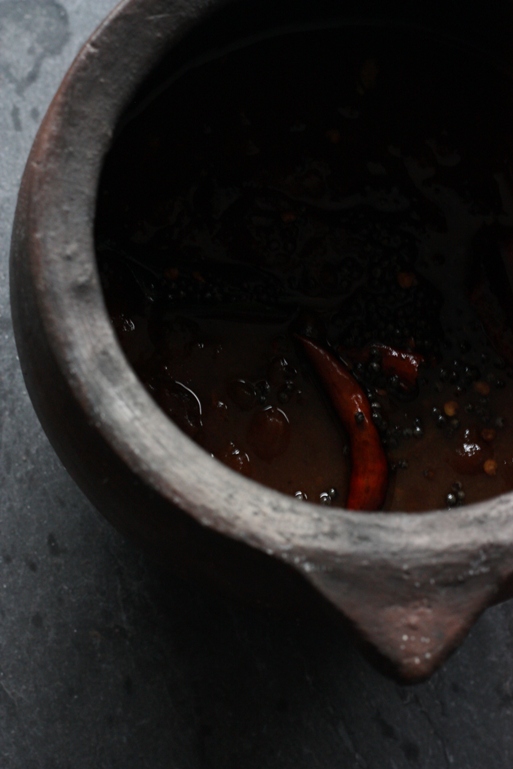 |
| Tamarind Pods for Puli Inji/ Tamarind Chutney for BWW #158 |
Thank you! to Cinzia who blogs at Cindystar and Susan, The Well Seasoned Cook. Tiffin Carrier Antic/que's! is honoured to host the Black and White Wednesday # 158.
This goes to the Black and White Wednesday #158 hosted here.
 |
| Puli Inji/ Tamarind Chutney |
 |
| Traditional Valluvanad Puli Inji/ Traditional Valluvanad Tamarind Chutney |
 |
| Sugar Cane Jaggery Cubes |
Puli Inji translates into a generic Tamarind Chutney from Kerala. It does not carry the subtle but important variations in the recipe. Inji Puli will bring you a different recipe. Every region in Kerala has its own version. The Inji Puli/ Puli Inji served in Trivandrum / Thiruvananthapuram has a distinct and different flavour from that of South Malabar. This is old school, simple and spare.
The recipe was dictated to me thus: " this is the way we do... we used to do."
Pause, and a list of new ingredients and then,
"Vennamengil, inganaeyum cheyyam... pandonnum e parishkaaram illa! = "One can do this way also...however, earlier we did have these improvisations/additions"!
Important
The recipe was dictated to me thus: " this is the way we do... we used to do."
Pause, and a list of new ingredients and then,
"Vennamengil, inganaeyum cheyyam... pandonnum e parishkaaram illa! = "One can do this way also...however, earlier we did have these improvisations/additions"!
Important
- Ginger is not sauted, it is boiled with tamarind.
- Green Chillies are not sauted, they are boiled with tamarind.
- Except for the traditional tempering ingredients of mustard, curry leaves and dried red chillies, nothing else is added.
- The 'sweetness' can be increased according to preference and also depends on the quality of the jaggery used.
The Puli or Tamarind itself is special. Only ripe, dark brown pods were chosen. The ripe pod, is carefully shelled, de-seeded, layered in old Chinese Porcelain Pickling Jars with rock salt, lids sealed with jackfruit gum and left to mature. The tamarind melts with the salt into a thick, glistening, black, almost-wet, paste-like consistency. In old houses, there would be a stock of tamarind pastes in the attic, at different stages of maturation.
Tamarind Paste available in Indian Groceries.
I have not used any 'liquid' varieties nor have I used non-Indian Tamarind products. There is little choice among the Indian tamarind pastes available.
The widely available variety is filled with seeds, bits and pieces of outer shell, smaller, soft, unripe seeds within their white covering and the stringy bits. It is also a hard slab. Packaged tamarind needs to be soaked, cleaned of the seeds, strings and inner seed-coats, then strained to yield a smooth paste.
- Cut out the required piece, soak it in small amount of room temperature water.
- To speed up the process use hot water.
Use your hands to separate the soaked pulp from the debris and then strain the pulp if you want a smooth tamarind paste.
In the amount of tamarind used here, approximately 100 gms, I weeded out handful of seeds. And this is the 'wet paste' variety among Indian brands.
In the amount of tamarind used here, approximately 100 gms, I weeded out handful of seeds. And this is the 'wet paste' variety among Indian brands.
Ingredients
- Approximately 3 walnut sized balls of Puli = tamarind/ 3 heaped tbsps of tamarind paste/ approximately 100 gms
- 3-4 hot green chillies, sliced
- 2 tbsps of finely chopped Inji = Ginger
- 2 cubes of indian jaggery or more according to your preference.
- Salt
 |
| Puli Inji/ Tamarind Chutney with tempering |
For Tempering
- 1 tbsp of coconut oil
- 1 tbsp of mustard seeds
- 2-3 dried red chillies
- 1/2 stem of curry leaves
Method
- Soak the tamarind in hot water 1 cup-15 minutes
- Weed out any debris and strain the pulp.
- Add finely chopped ginger, green chillies and salt.
- Boil the pulp on medium heat at least for 5-8 minutes
- Once the pulp reduces a bit, add 2 jaggery pieces.
- Add small amounts of water- up to 1/2 cup or so to adjust the consistency if it tends to stick to the pot.
- Let the jaggery melt into the tamarind.
- Reduce the the pulp to your consistency.
Tempering
- Heat coconut oil to smoking point
- Reduce the heat and immediately add the mustard seeds, broken red chillies and curry leaves.
- Pour it over the cooked Puli Inji.
- It will stay outside for a couple of days but refrigeration will ensure that it will stay for at least a week and more.




you have a kalchatti, oh dear how I wish I had one.
ReplyDeleteLovely pictures of the lipsmacking good puli inji.
Thank you Lata! This is not a kalchatti, it is a manchatti/ Claypot. Everytime I try to bring the kalchatti it gets discarded from the suitcase at the end due to the weight. Definitely next time. :-)
DeleteThose first couple of pics had my mouth watering. Has been a long time since I have plucked one off the tree. And the picture brought back those memories.
DeleteThank you Radha; and yes, it has been years since I had the fresh green & then the in-between stage of ripening soft moss-green-brown pods..... Increasingly one can find these pods in regular grocery stores and in ethnic groceries.
Delete